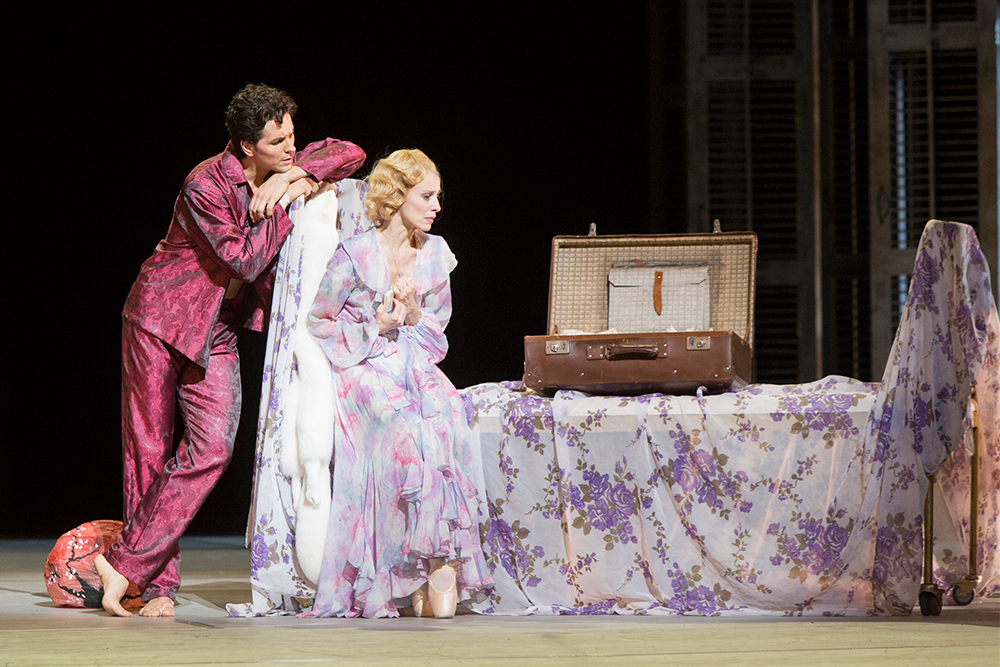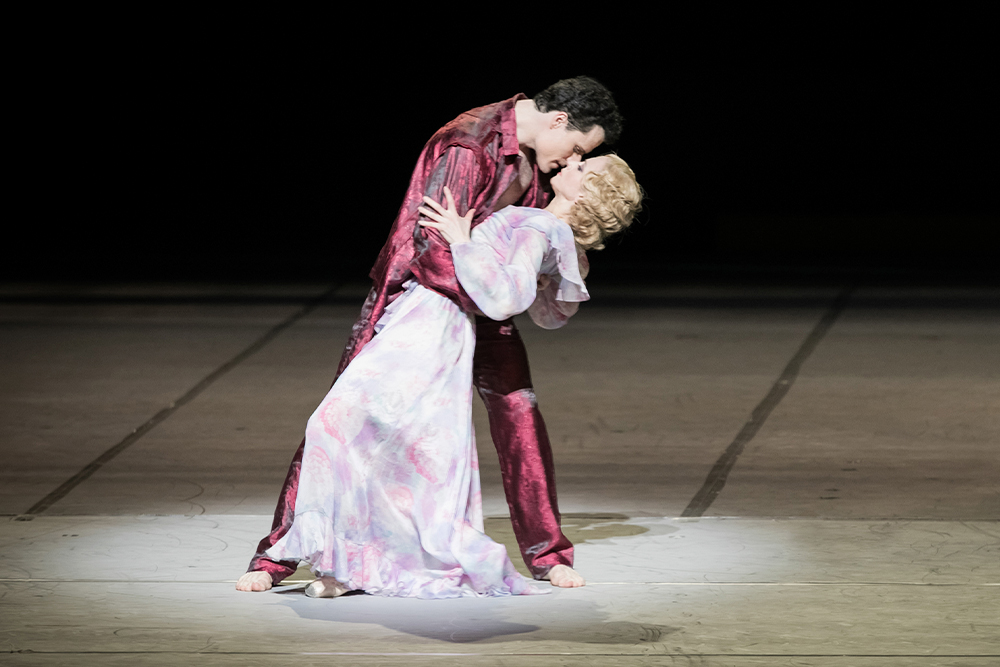Ballet
Nouvelles+
Intimacy Consultant Anisa Tejpar
Un Tramway nommé Désir
15 février 2022

Anisa Tejpar. Photo by Tim Leyes.
The National Ballet of Canada is opening the Winter Season with John Neumeier’s A Streetcar Named Desire, inspired by Tennessee Williams’ Pulitzer Prize-winning play of the same name. It’s a gritty, dramatic ballet that visualizes many of the play’s powerful themes and it doesn’t shy away from Stanley Kowalski’s brutal rape of Blanche DuBois, the culmination of a festering culture clash.
For the company premiere of Streetcar in 2017 and again this winter, audiences are receiving advance warning of scenes of sexual and physical violence in all communications about the production. This year Hope Muir, Joan and Jerry Artistic Director, has taken the additional step of hiring an Intimacy Consultant for Streetcar to help the dancers feel safe and supported as they rehearse and perform. This is the first time the company has provided this service. Below, Anisa Tejpar shares the important work she’s being doing for The National Ballet of Canada.
You’ve enjoyed such a varied career in dance and the performing arts. What are some of the things you do right now?
I occupy an unusual space in dance making. First and foremost, I am a dancer. A graduate of Canada’s National Ballet School, I did not pursue ballet as my medium. Instead, I embraced contemporary dance, working for companies like Toronto Dance Theatre and ProArteDanza and many independent projects. I am a devoted and active member of the independent dance community as an interpreter and choreographer. As a busy rehearsal director, I provide an outside eye and act as project manager and creative consultant on new creations for choreographers. Concurrently, I have always produced my own works for shows, events and more commercially through my firm Hit & Run Dance Productions.
I have and continue to work in film and television as well as video games, and I produce and host a show called Inside the Arts on Sauga 960AM. In the realm of education, consultation and instruction, I teach Consent + Boundaries at X University (formerly Ryerson University) as well as ballet. In a burgeoning, exciting and ground-breaking field, I am also an Intimacy Coordinator and Director for stage, screen and dance.

Guilluame Côté and Sonia Rodriguez in A Streetcar Named Desire. Photo par Aleksandar Antonijevic.
What does intimacy work entail and how do you train or qualify for it?
Essentially, the role champions the well-being of the artists who participate or engage in intimate or emotionally charged stage or screen experiences and encounters. This requires creating a safe and trusting relationship with performers, having confidential and direct discussions and advocating on their behalf with the production players.
I trained with various organizations in the US, Canada and the UK from leaders in this field. I learned from the best in a variety of subjects, such as Mental Health First Aid, Bystander Intervention, Consent + Boundaries, Psychological First Aid, Race + Intimacy and Gender. I learned how to stage intimate content, coach it, talk about it and create it, all with storytelling at the forefront.
What motivated you to pursue this kind of work and was there a model for it?
Given the rapid evolution in boundary and sensitivity awareness over the last few years, I started to pursue this work because I saw a huge void in dance relative to other media. Because of the implied consent in the dance world that accompanies touching and partnering with colleagues, I wanted to find a way to make it safer for performers to share sensitive content without taking away the amazing trust and physical athleticism of dance or detracting from the art form. Dance is what I know, it is my first love and so it is the lens through which I view all my training and work.
Intimacy work is new to dance and especially to ballet. In dance (as in any performance art) performers are predisposed to say “yes.” While dancers are working to have complete control over their bodies, they are also expected to immediately surrender that control to the choreographer. These power dynamics are part of performance culture. Everything reinforces “yes” as the only option.
In the context of what artists are expected to do, my focus is to empower them to ask what they need in a process to feel free and safe, so that they can do their job exceptionally and without reservation with the support they need. The stories told in dance are important and there is no medium that possesses the passion and grit of dance. It is beautiful to watch and the experience uplifts us all. I am present in the room for the dancers to give them tools to separate themselves from their characters, make plans on how to execute the content safely, and to make sure there is an impartial eye, ear and advocate available for them along the way.

Jillian Vanstone and Guillaume Côté in A Streetcar Named Desire. Photo par Aleksandar Antonijevic.
How are you helping the dancers prepare for A Streetcar Named Desire?
I am the Intimacy Consultant for this ballet, which has already been created and is a remount for the National Ballet. Taking its cue from the play, the production has instances of simulated sexual assault, mental illness, suicide, homophobia, kissing and simulated sex. There is a lot to unpack and navigate through from the perspective of storytelling, as well the artists’ experience of staging it, rehearsing it and performing it. These are two different things: what the character experiences and what the artist experiences creating the characters. I have been brought on to support the artists and to set boundaries, plans and check-ins with everyone involved to ensure they are able to perform at their highest level, to access their boundaries and live within them and enjoy the process along the way.
Are you working only with the dancers who perform these scenes or is there a need to include the wider company as witnesses to them?
This is a great question! There is a very large bystander component for the performers who witness these intimate and triggering actions on stage. Although some are not actively performing these scenes or actions, they witness the actions repeatedly and are often on stage or in the wings themselves. Everyone has their emotional histories which are affected by a dramatic staging like Streetcar. I am available for the whole company and the dancers know that I can support their work however they need along the way.

Svetlana Lunkina and PIotr Stanczyk in A Streetcar Named Desire. Photo par Karolina Kuras.
What does a role like yours say about how ballet is evolving?
In the art of ballet, there has always been a remount or historical aspect to the performances. That being said, dance in general is always evolving, like every art form, and that includes the need for an Intimacy Professional. To me, it actually opens up a lot of doors for the content that can be tackled in dance. With rules and care, the performers can actually feel freer. Artists often find compelling ways to deal with boundaries and restrictions specific to their work, resulting in unexpected and creative opportunities. For writers and visual artists, the blank page can be frightening. In dance, having endless options can be overwhelming. But with context and consent, many more possibilities arise for new creations. Choreographers and artists who know they are supported can create bold and new artistic horizons to challenge and inspire the audience to feel and think differently. Dance can do that.
More About A Streetcar Named Desire
Sonia Rodriguez Says Farewell
